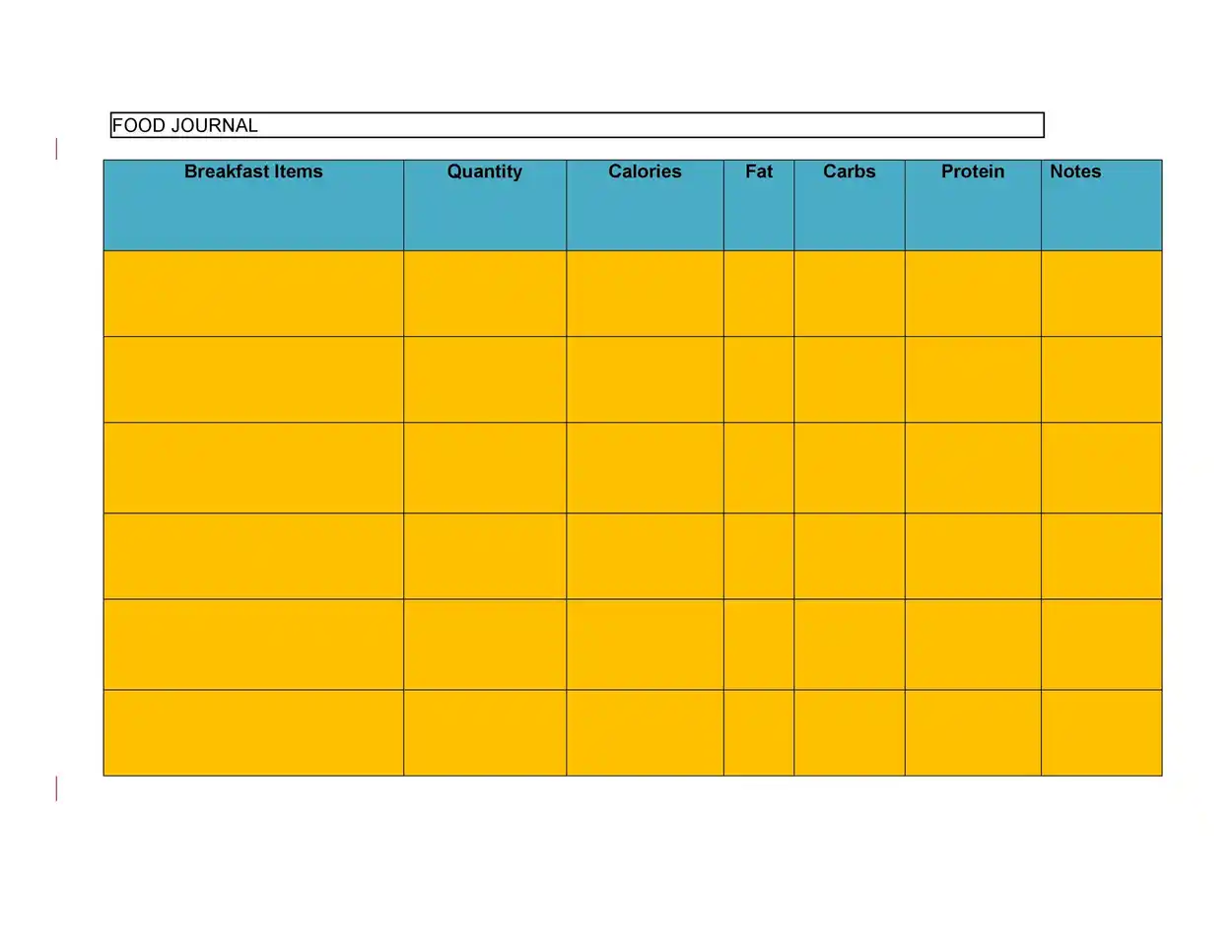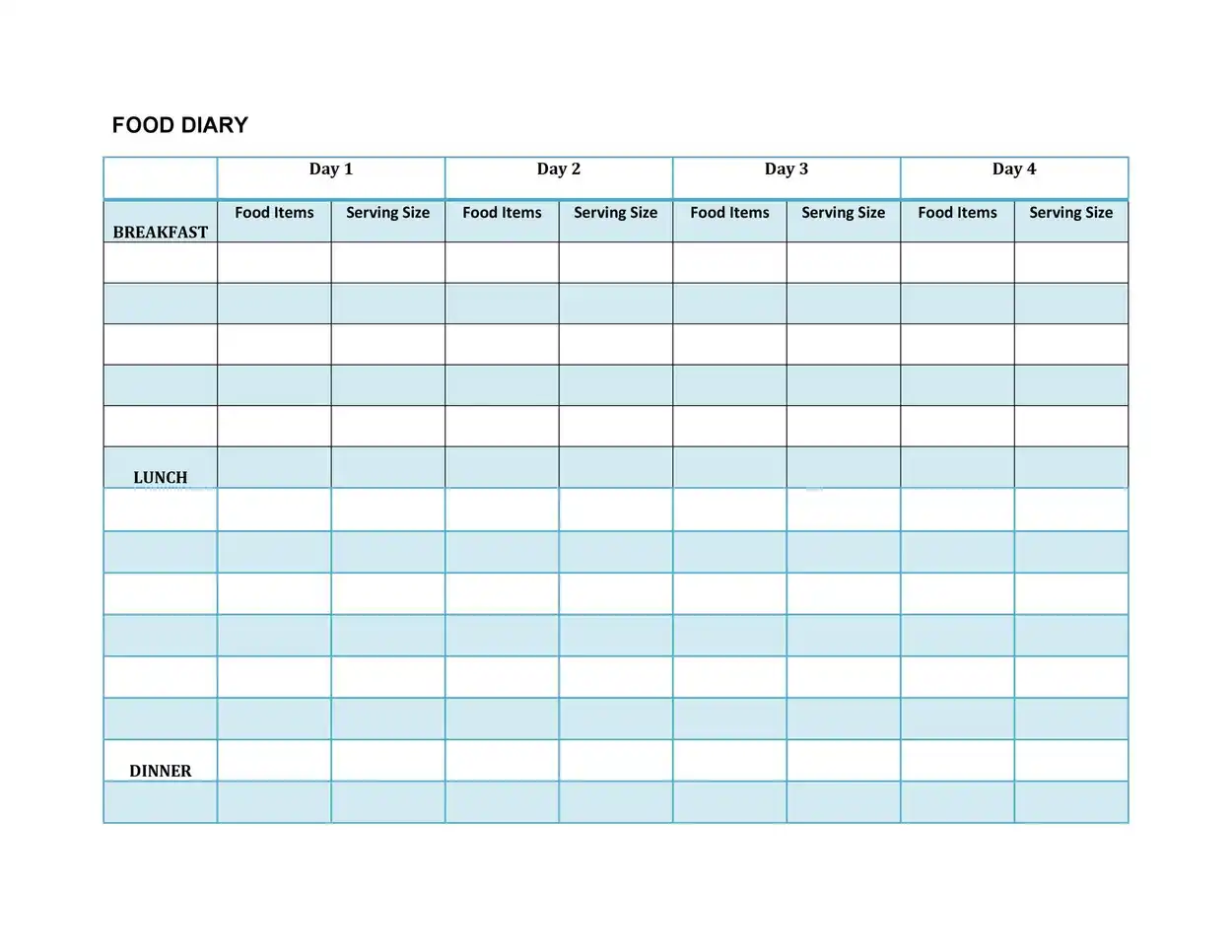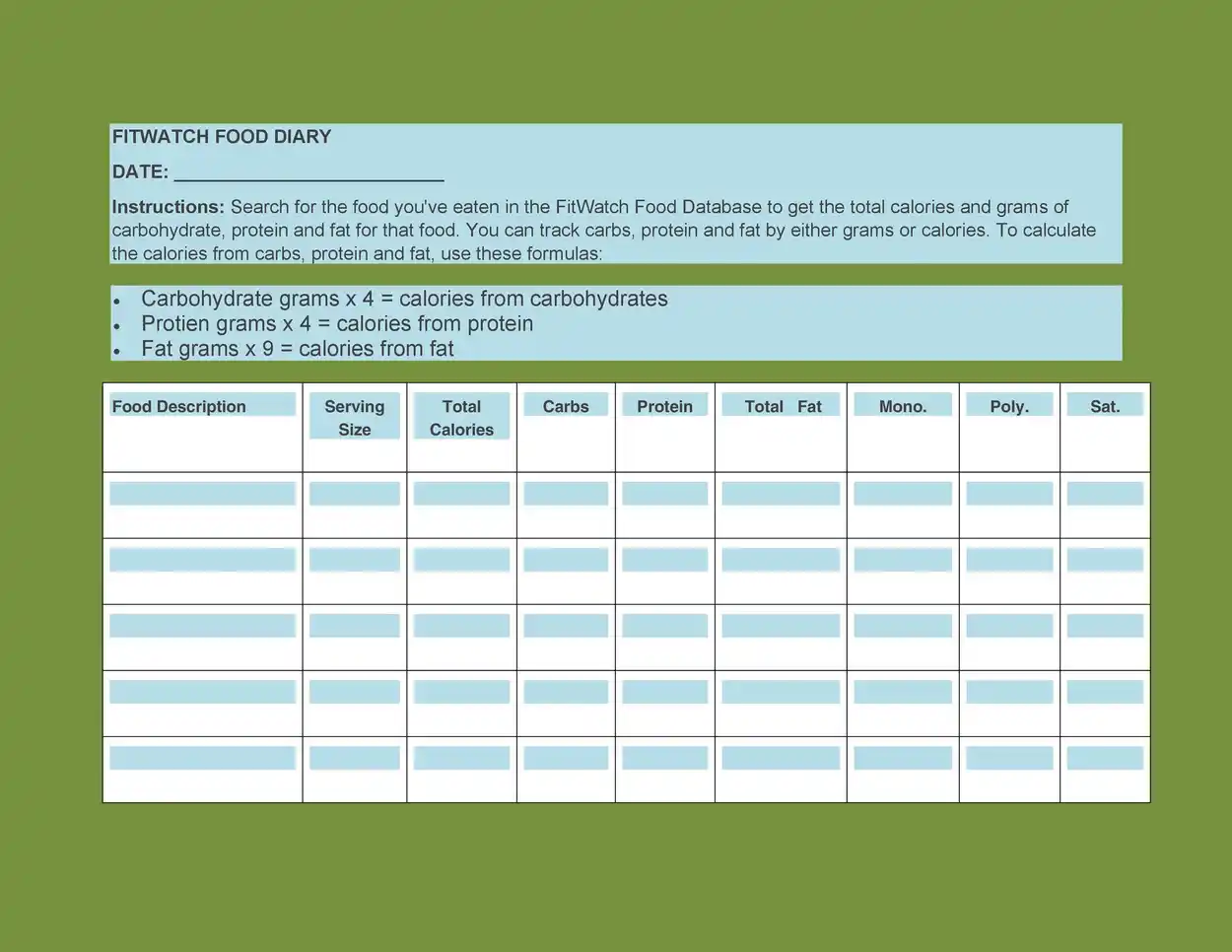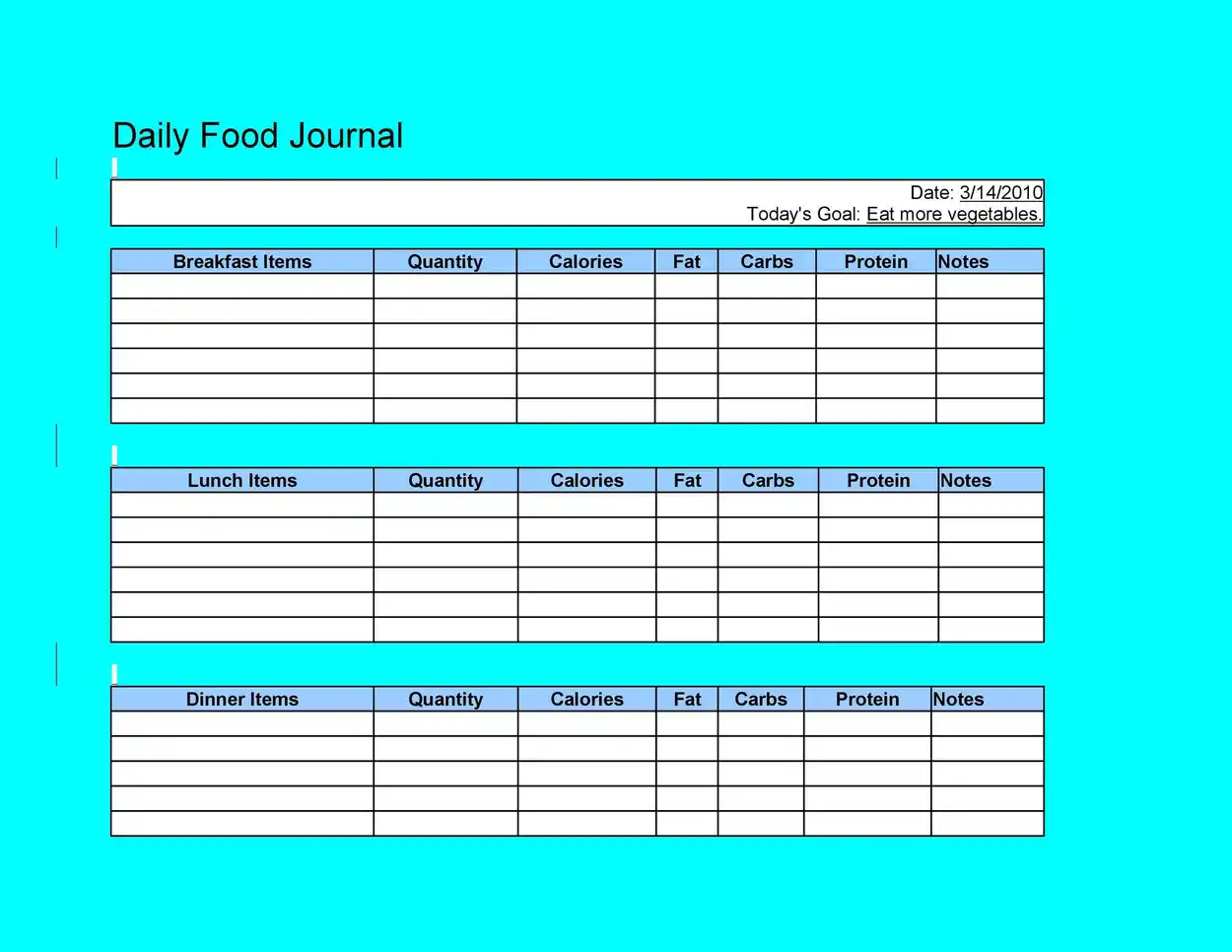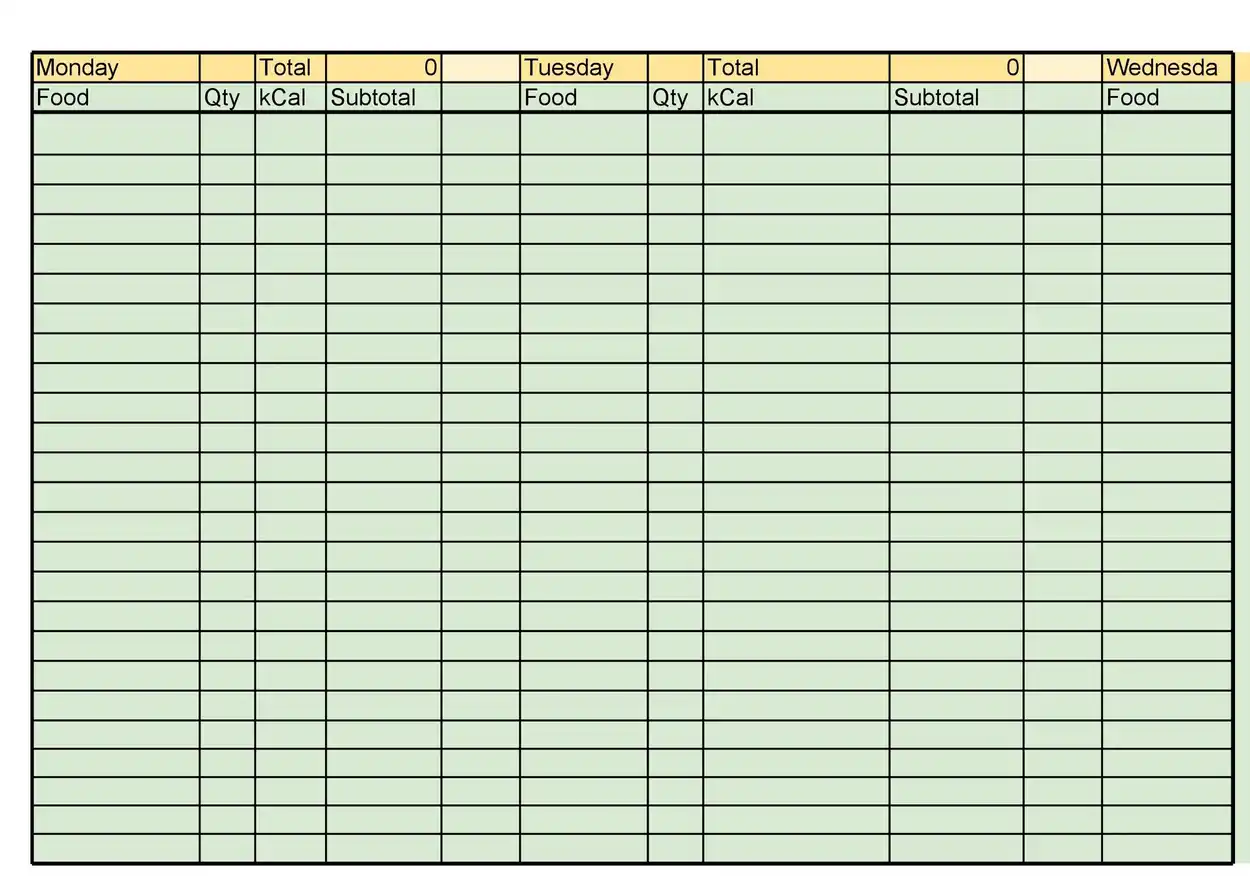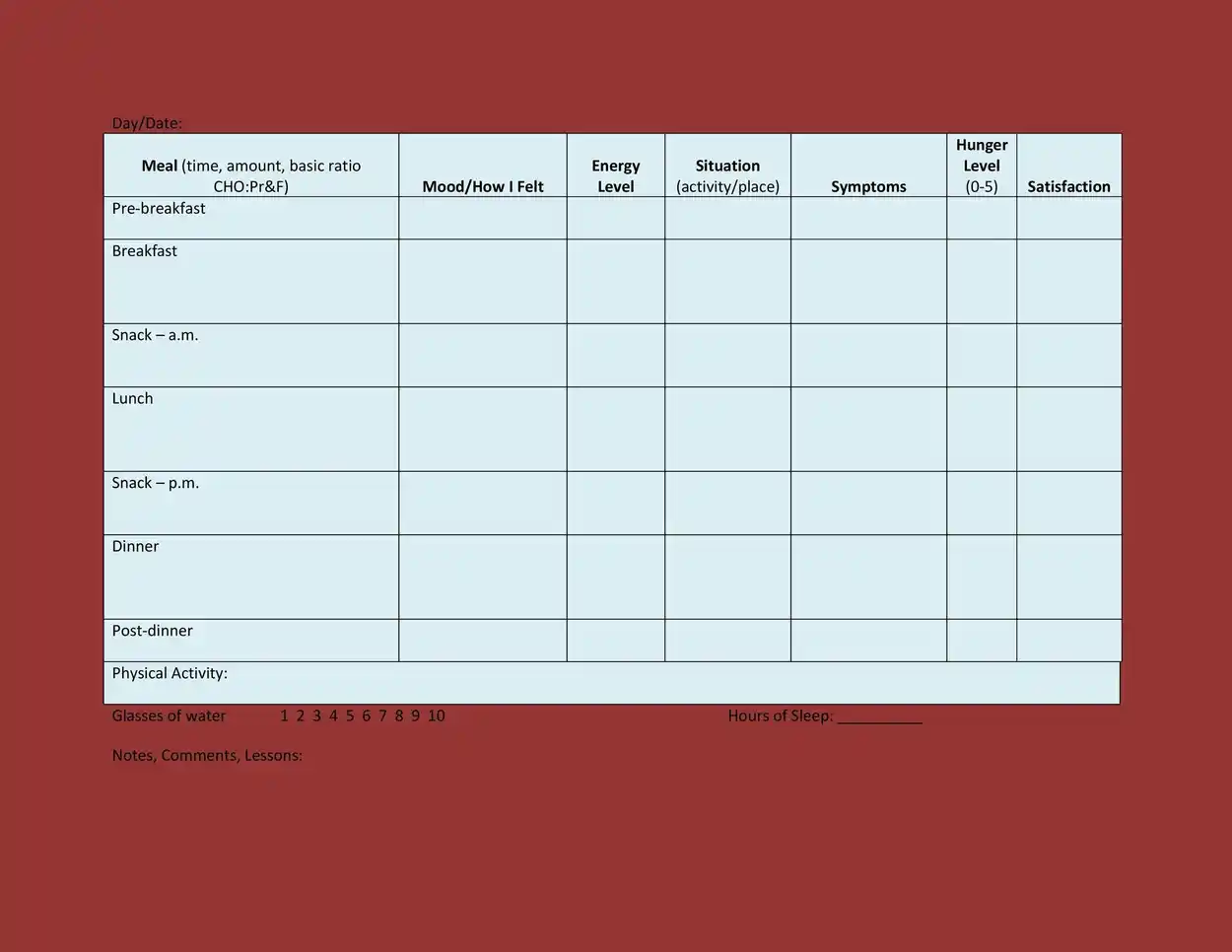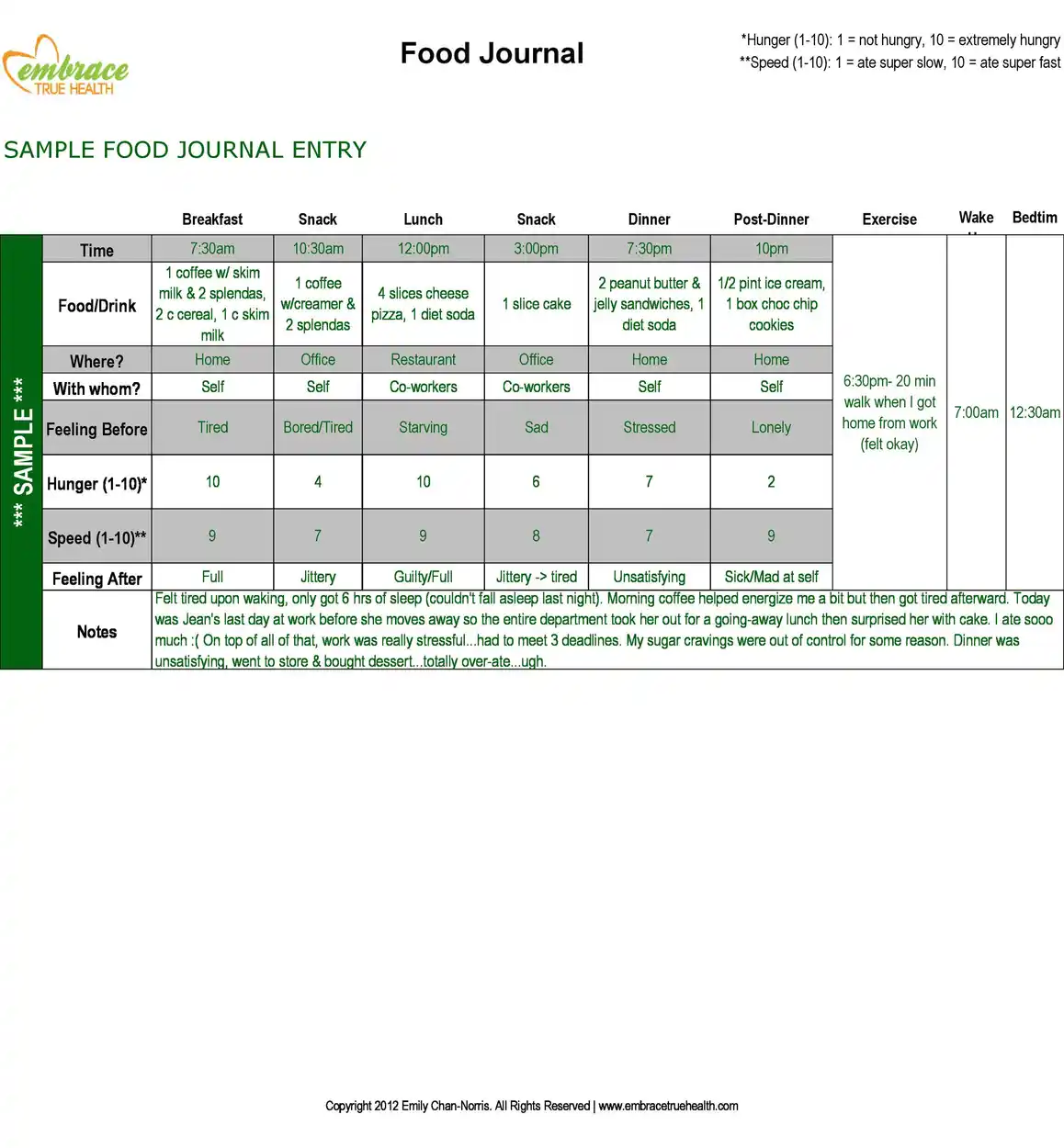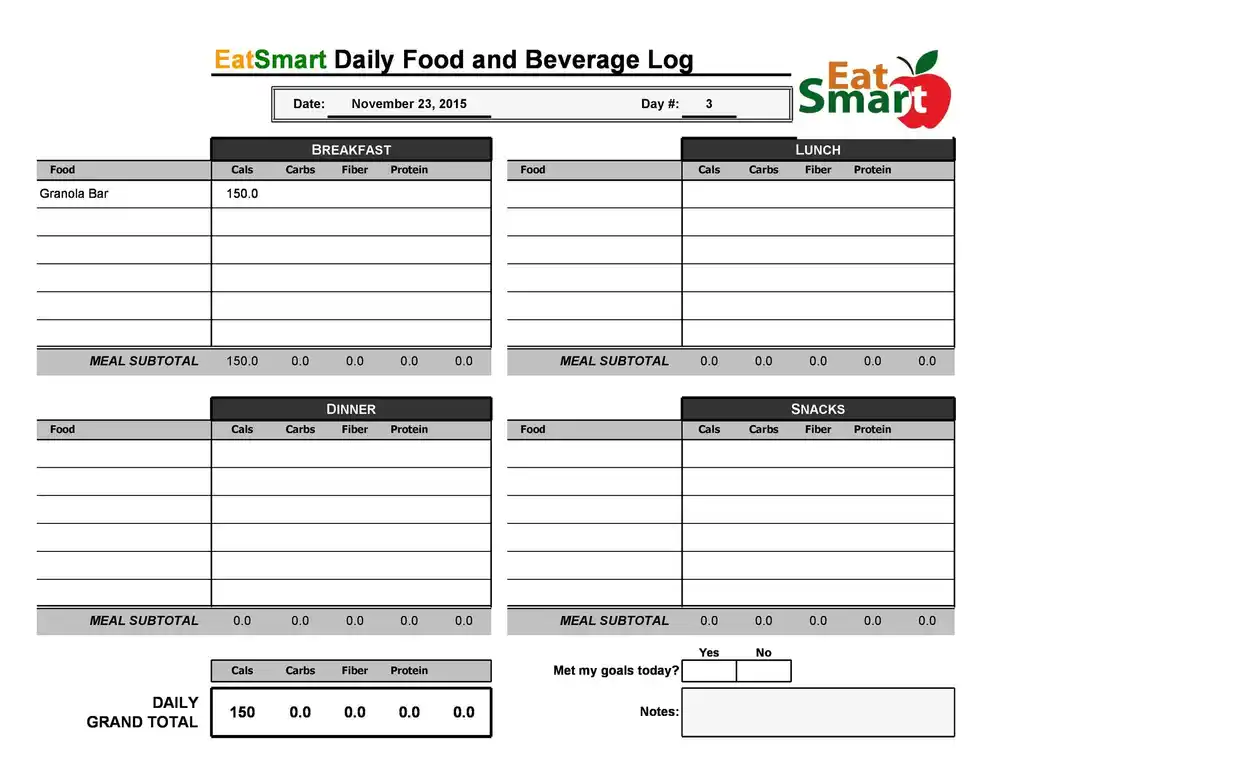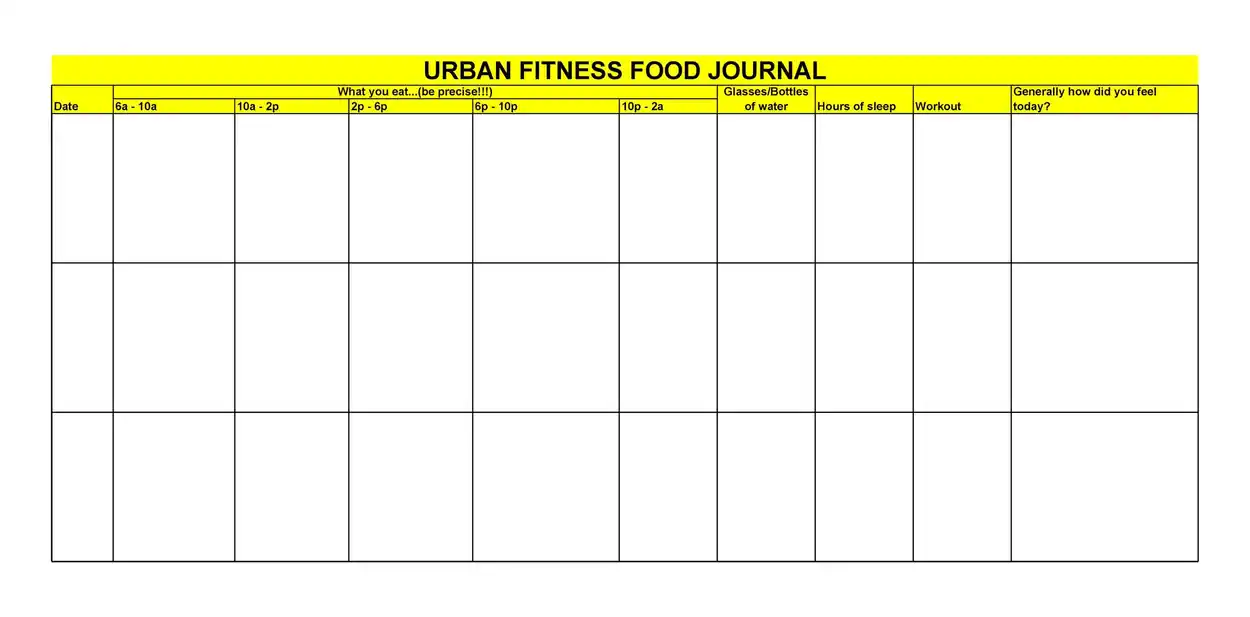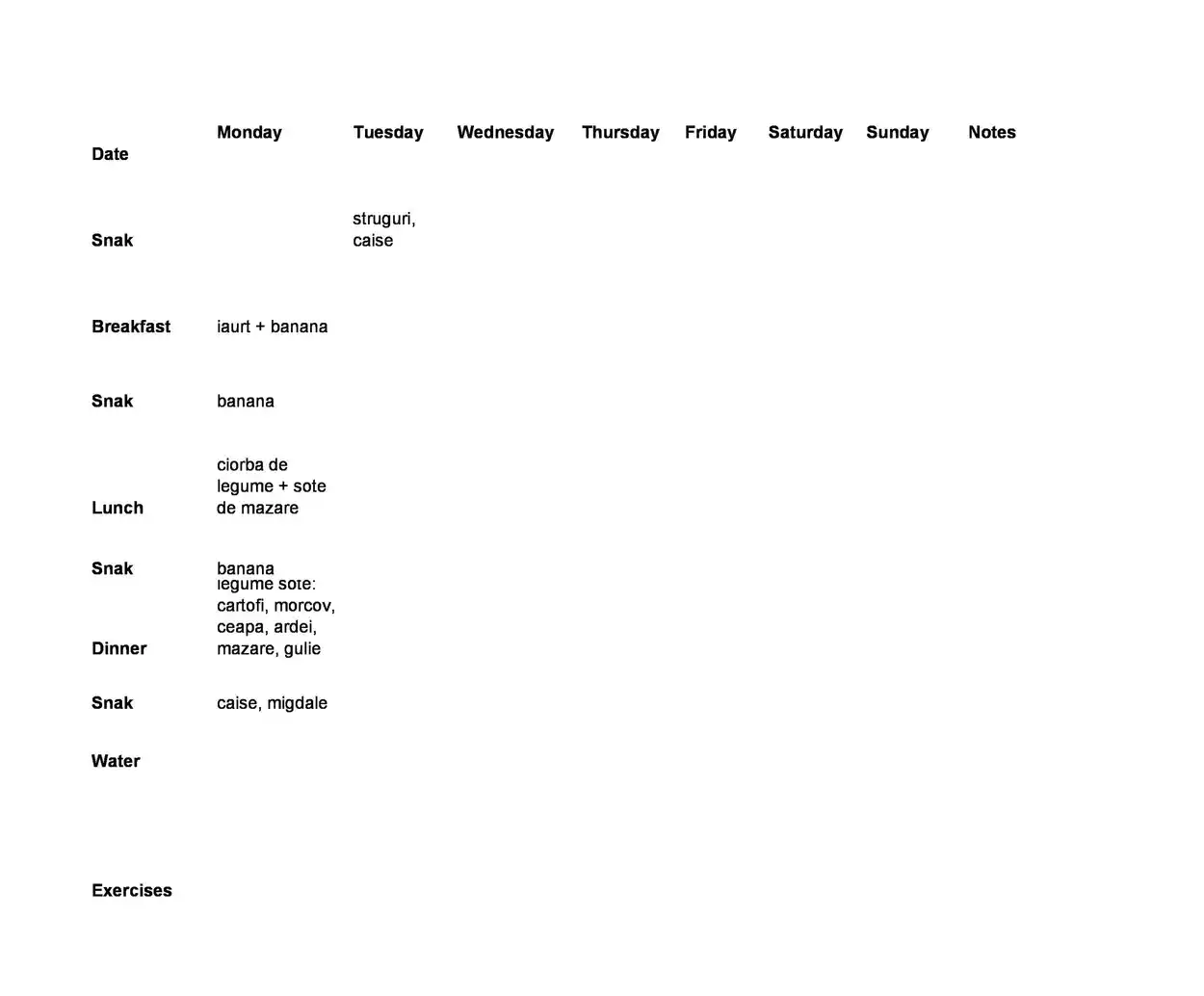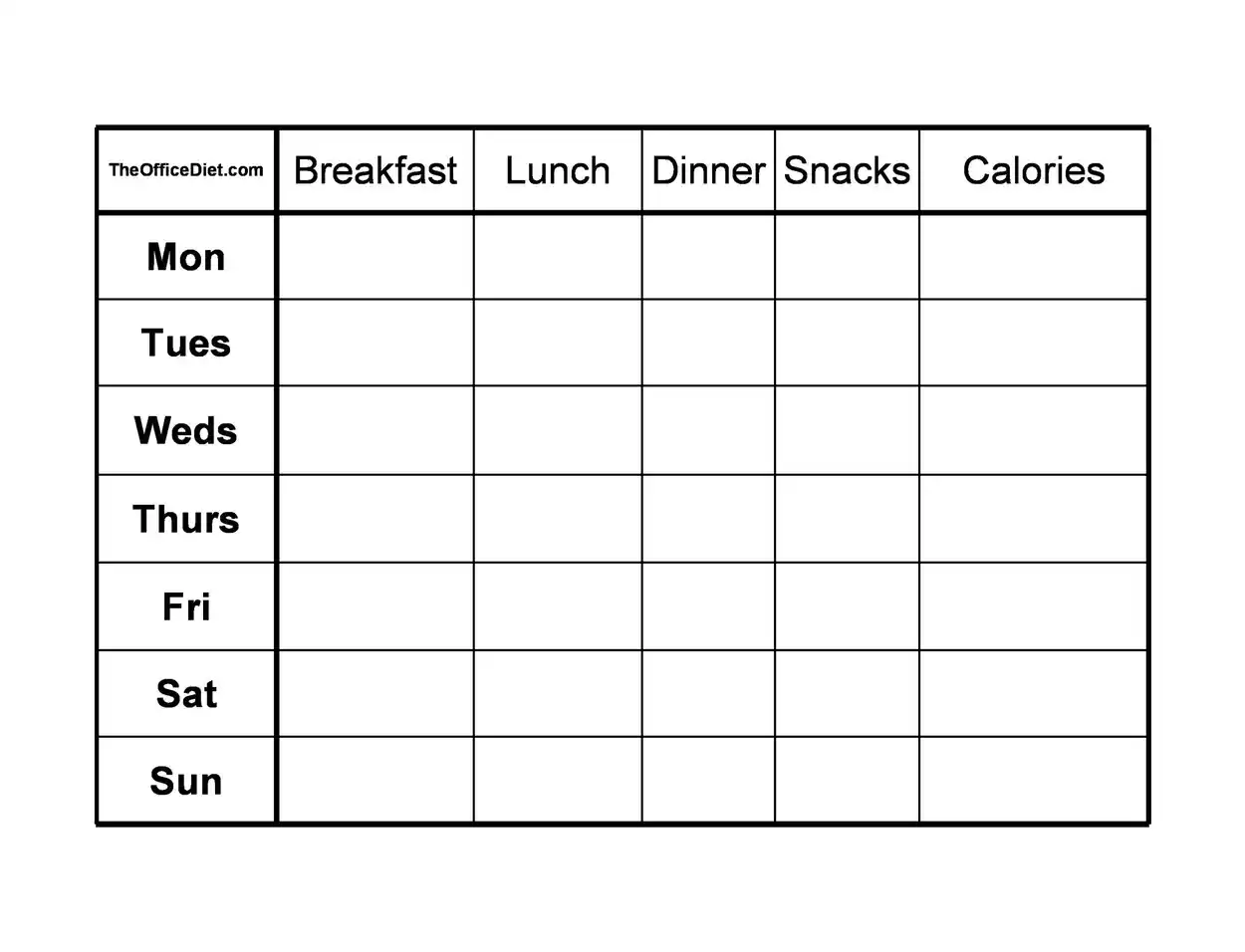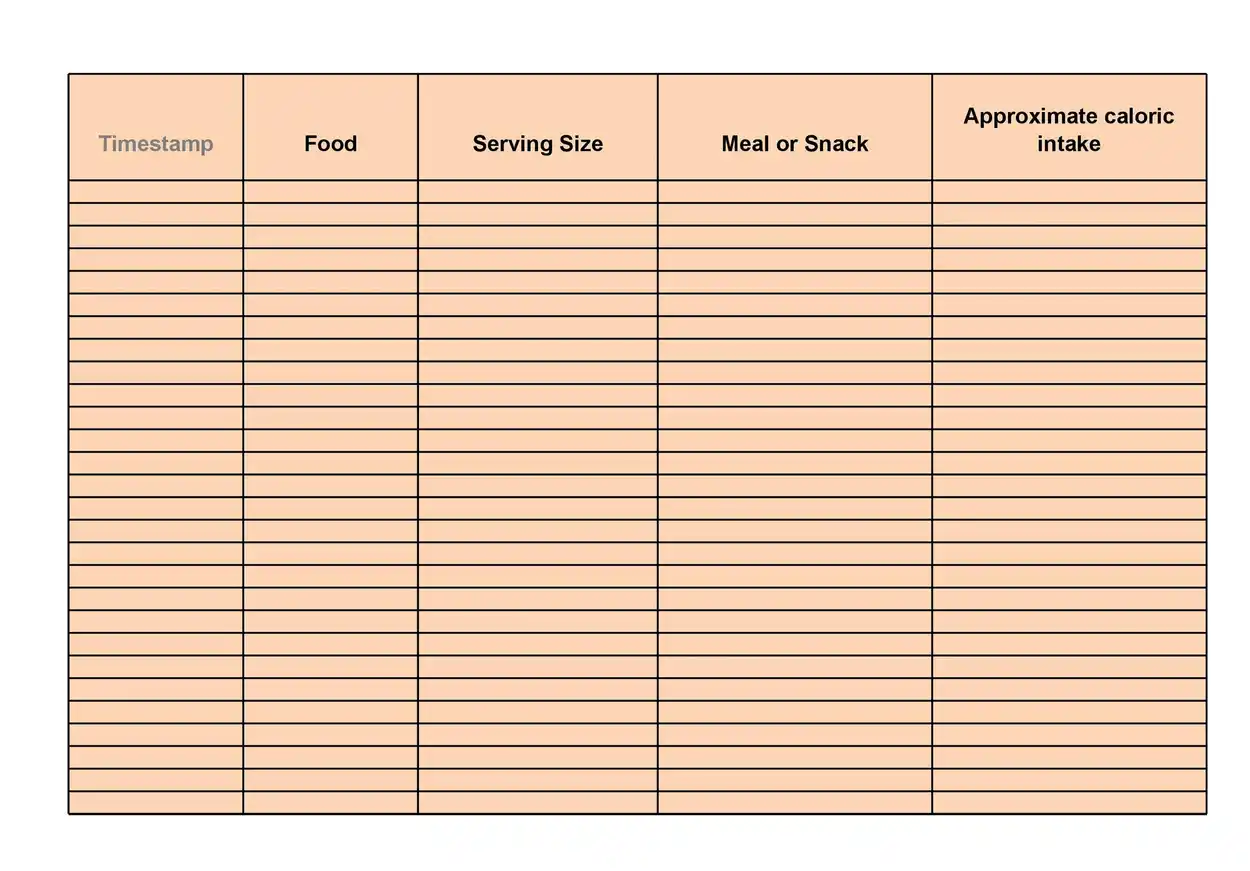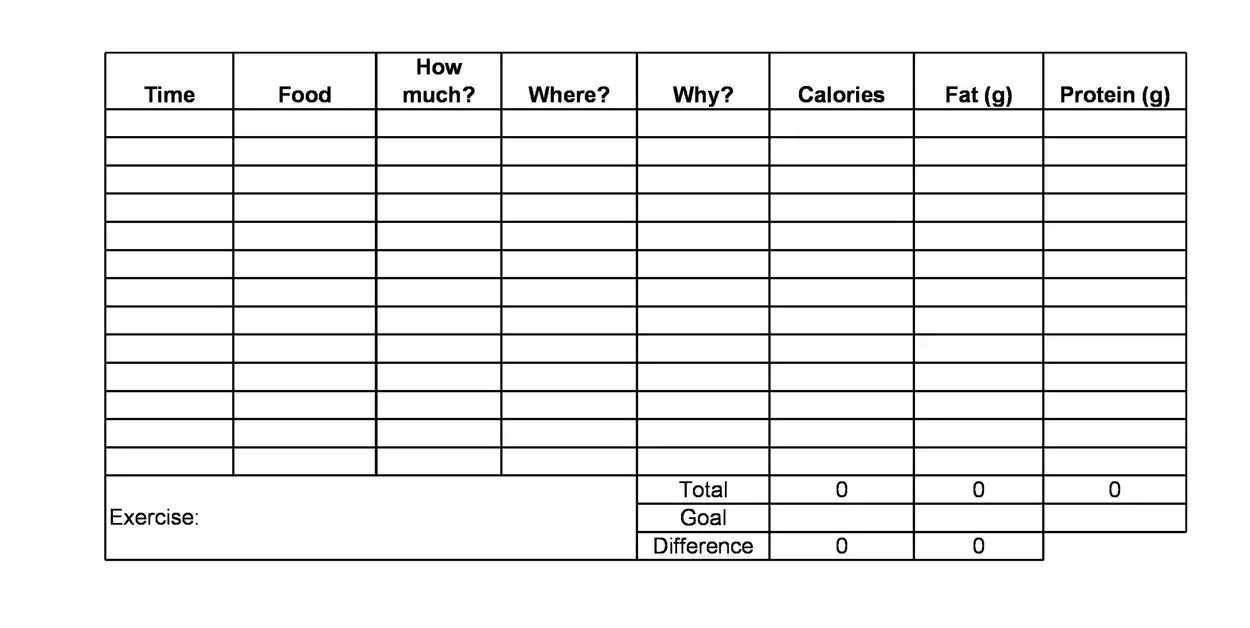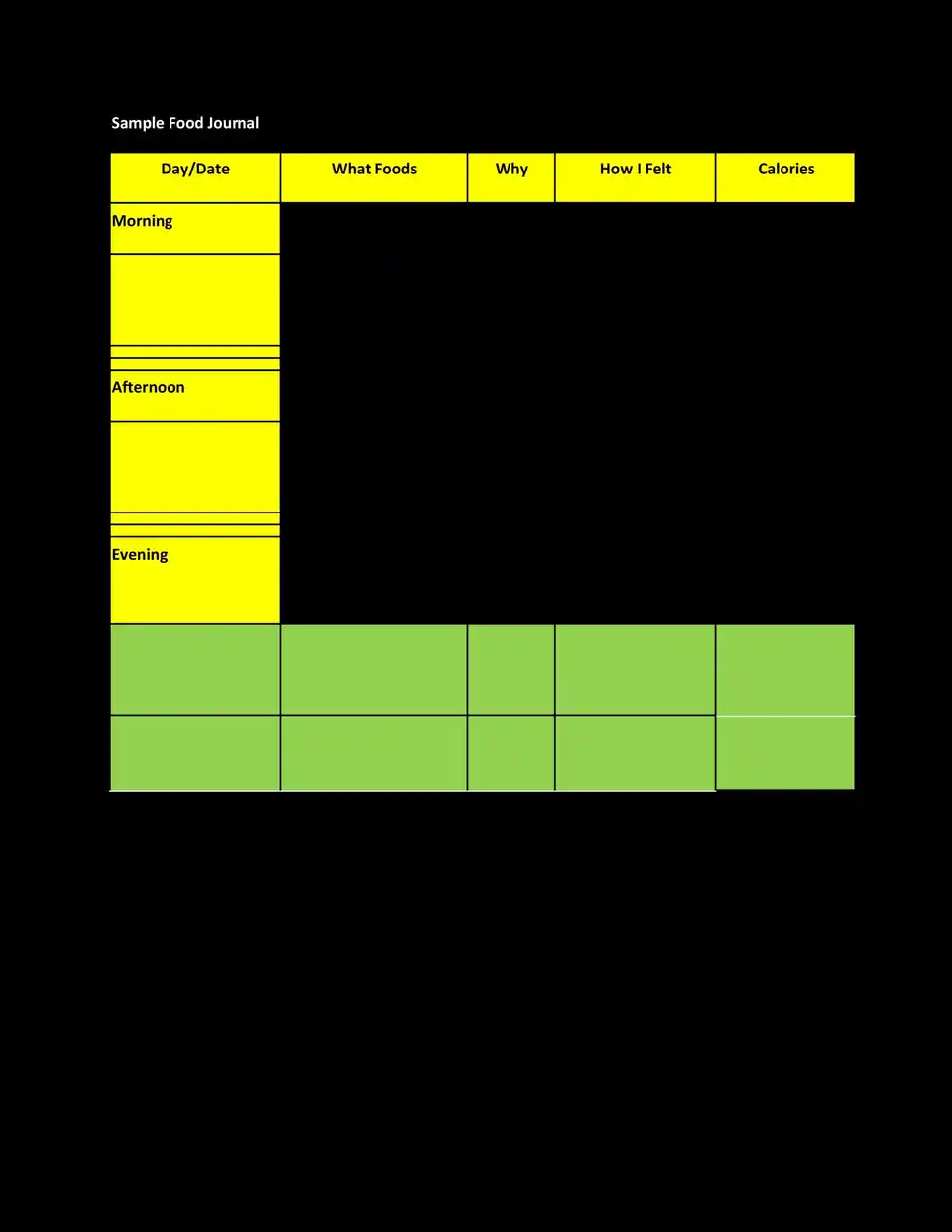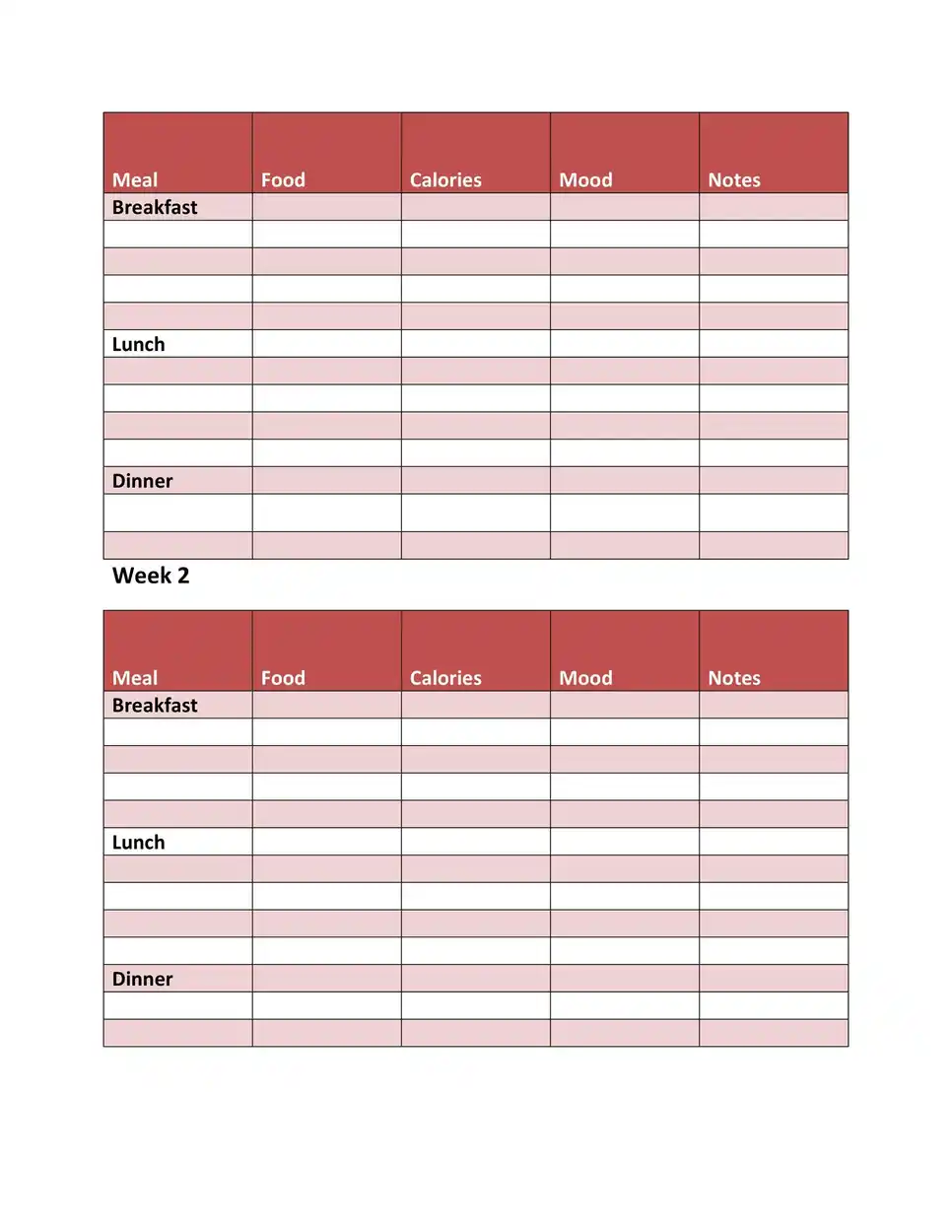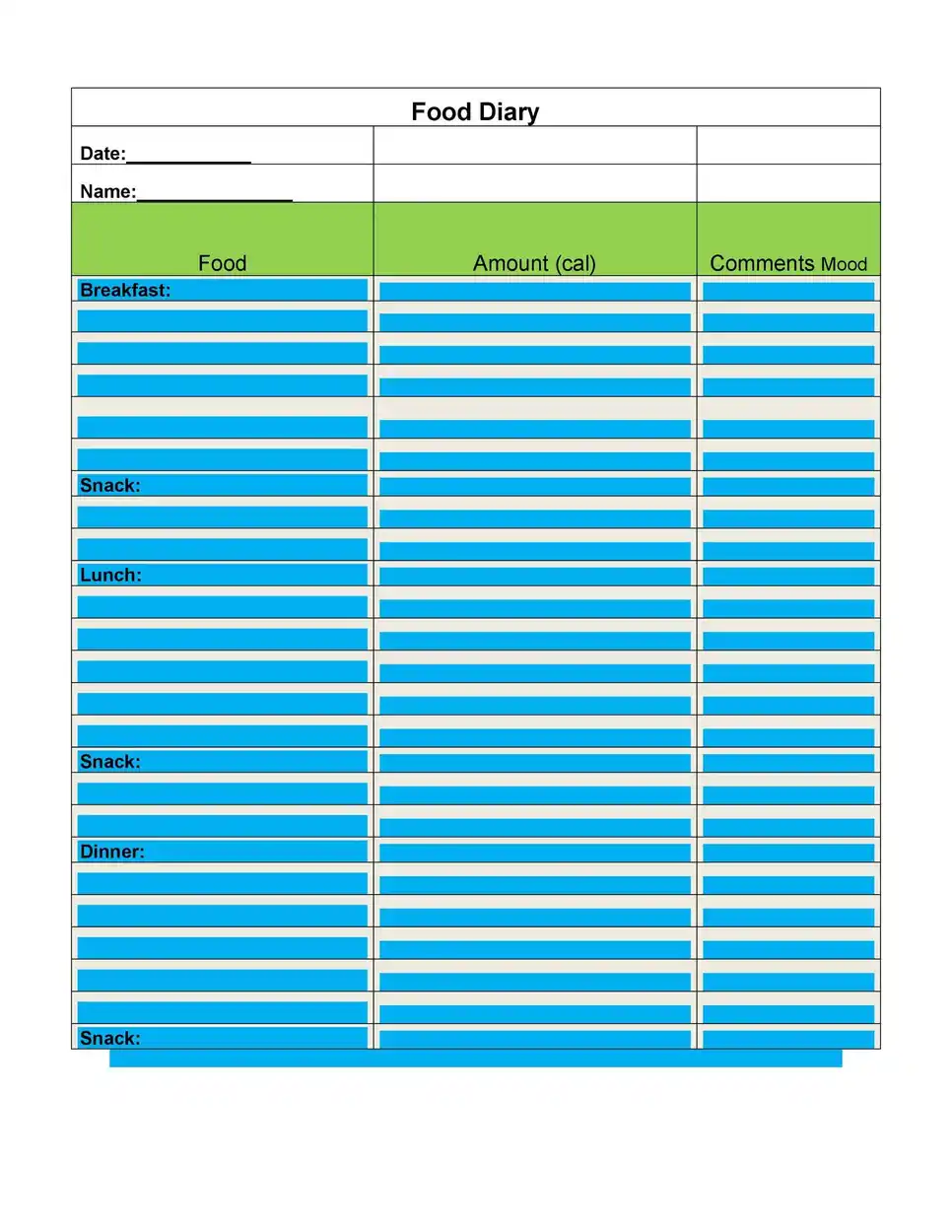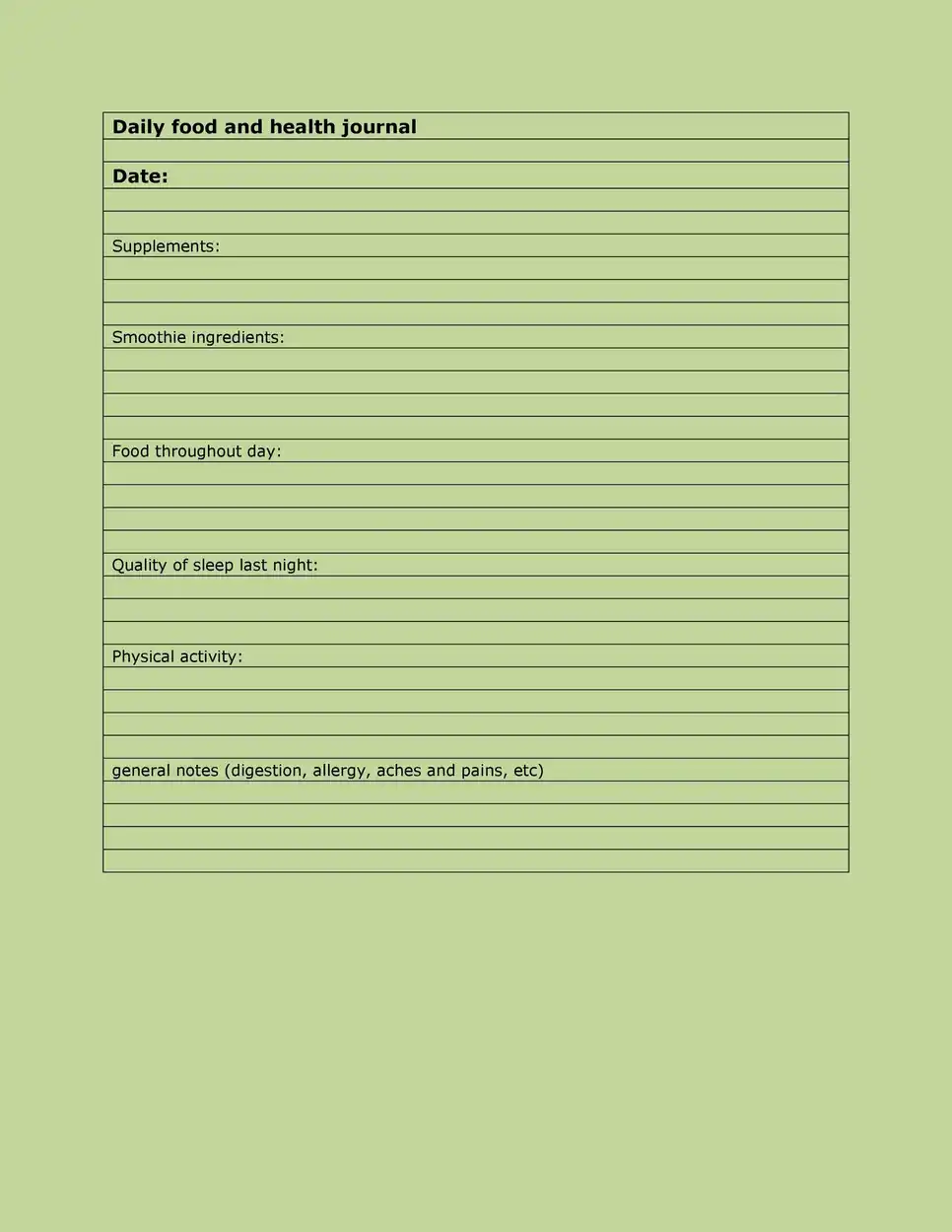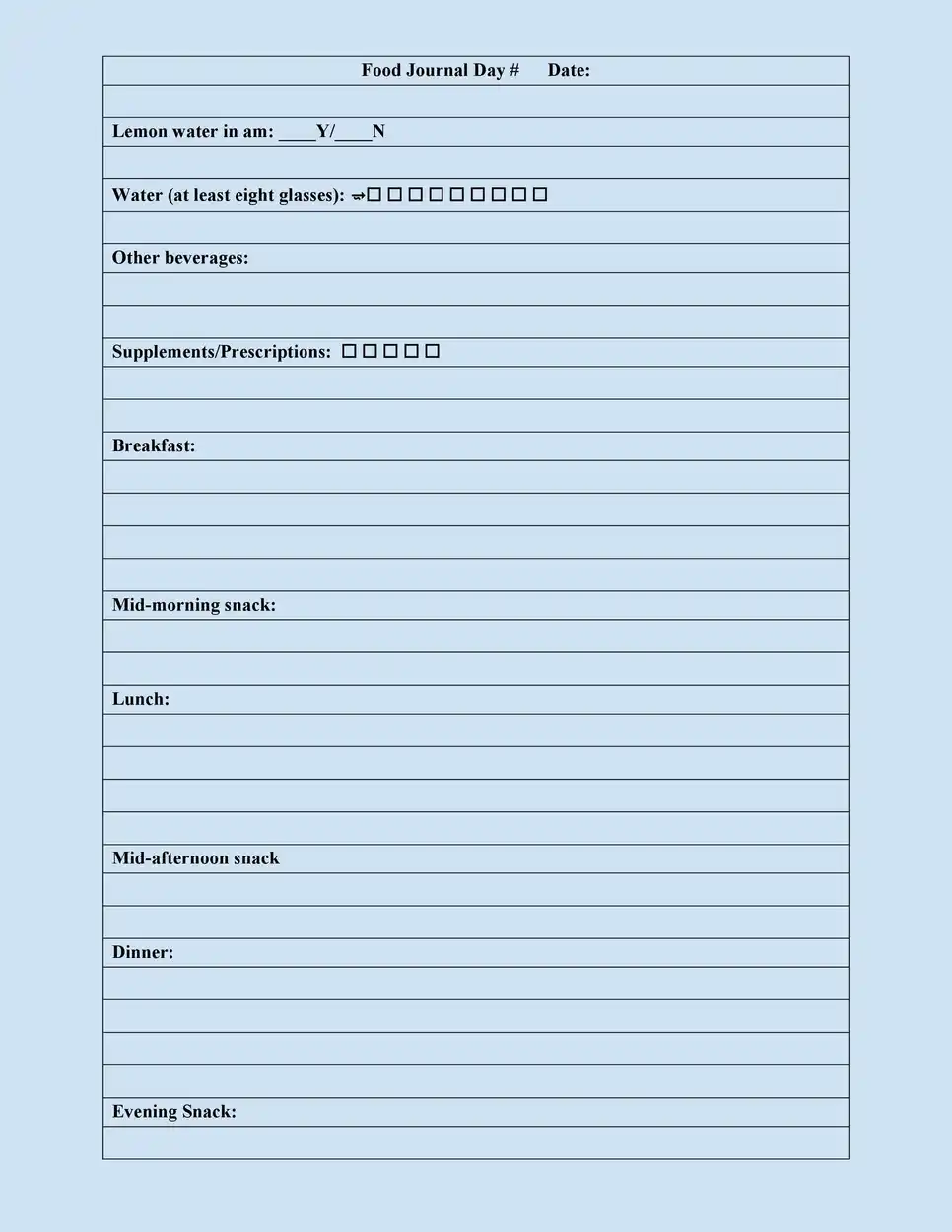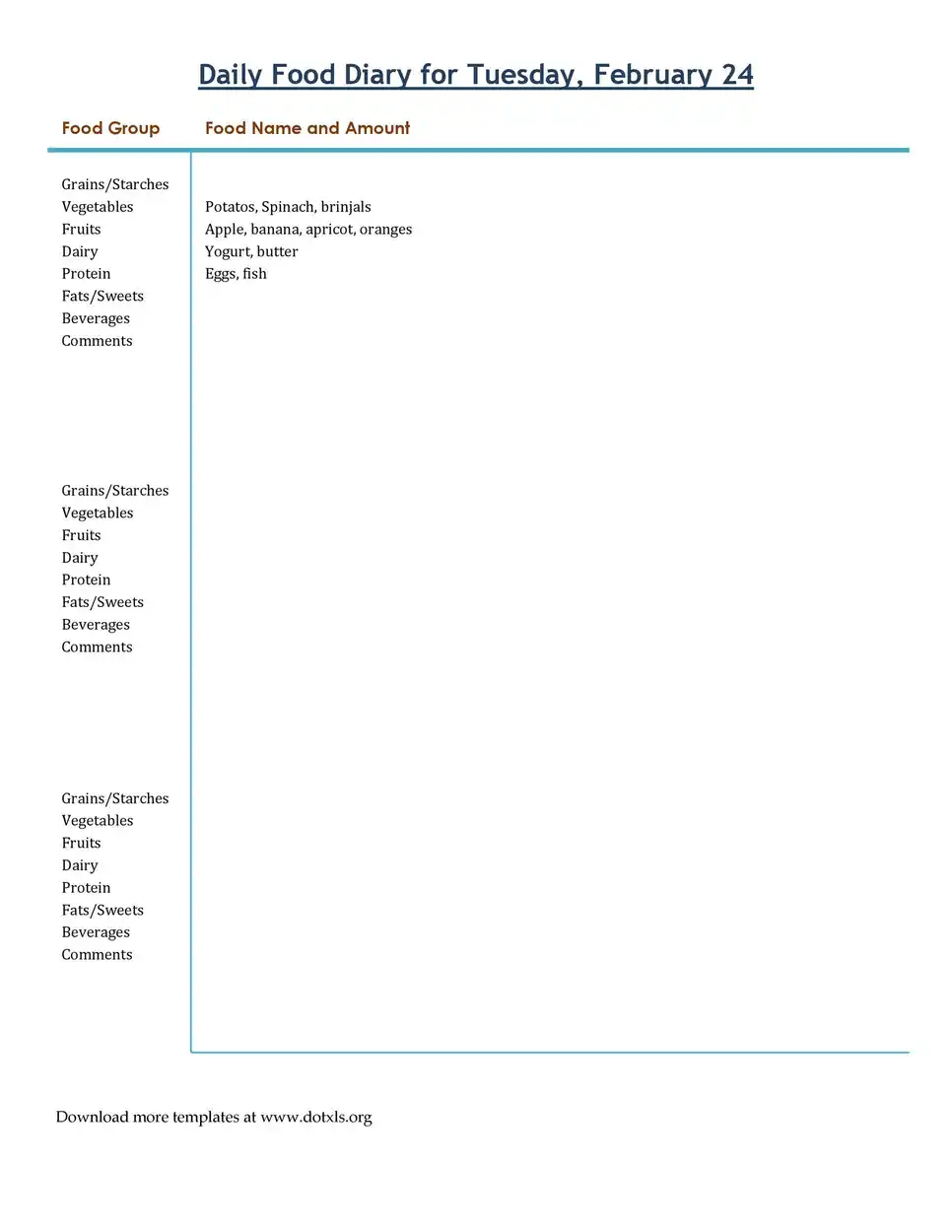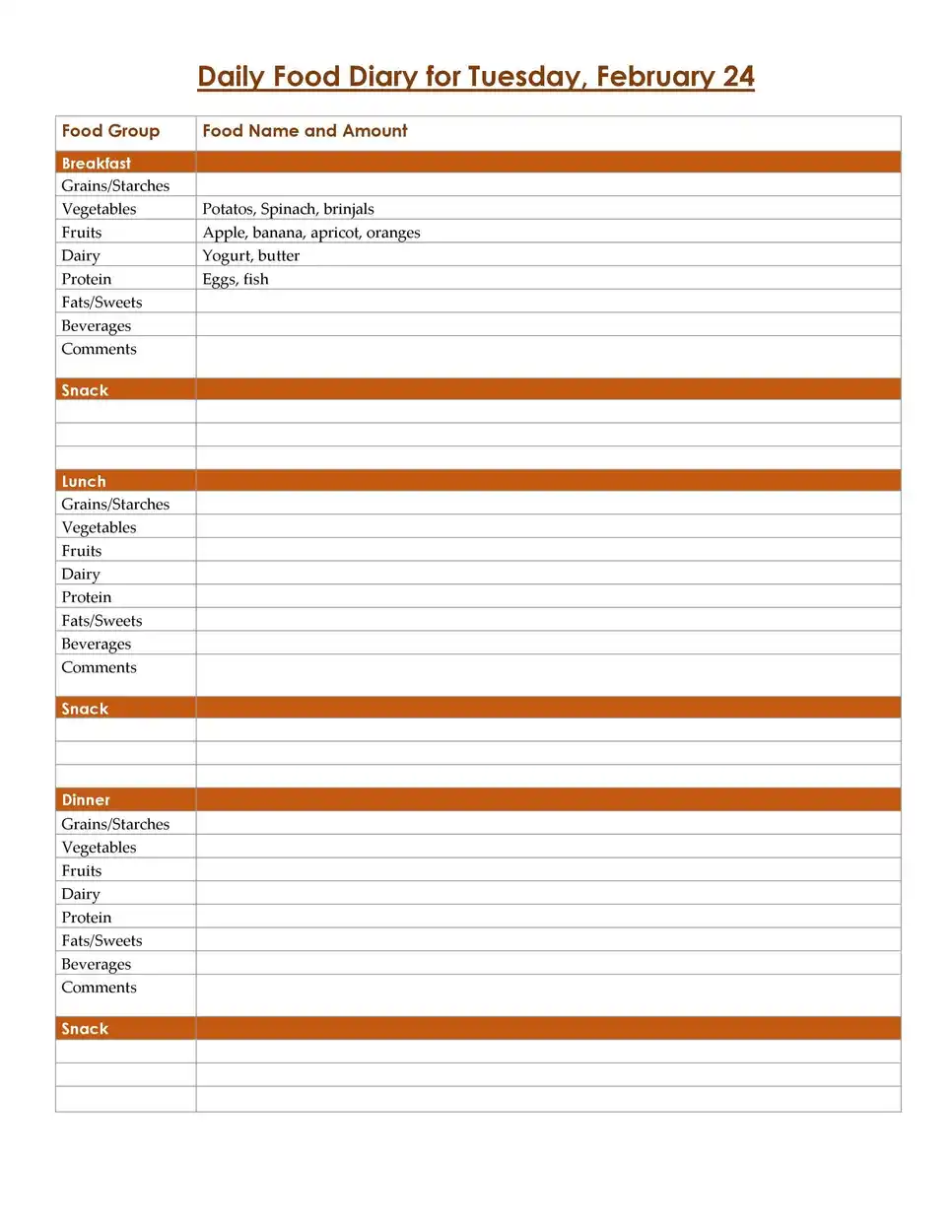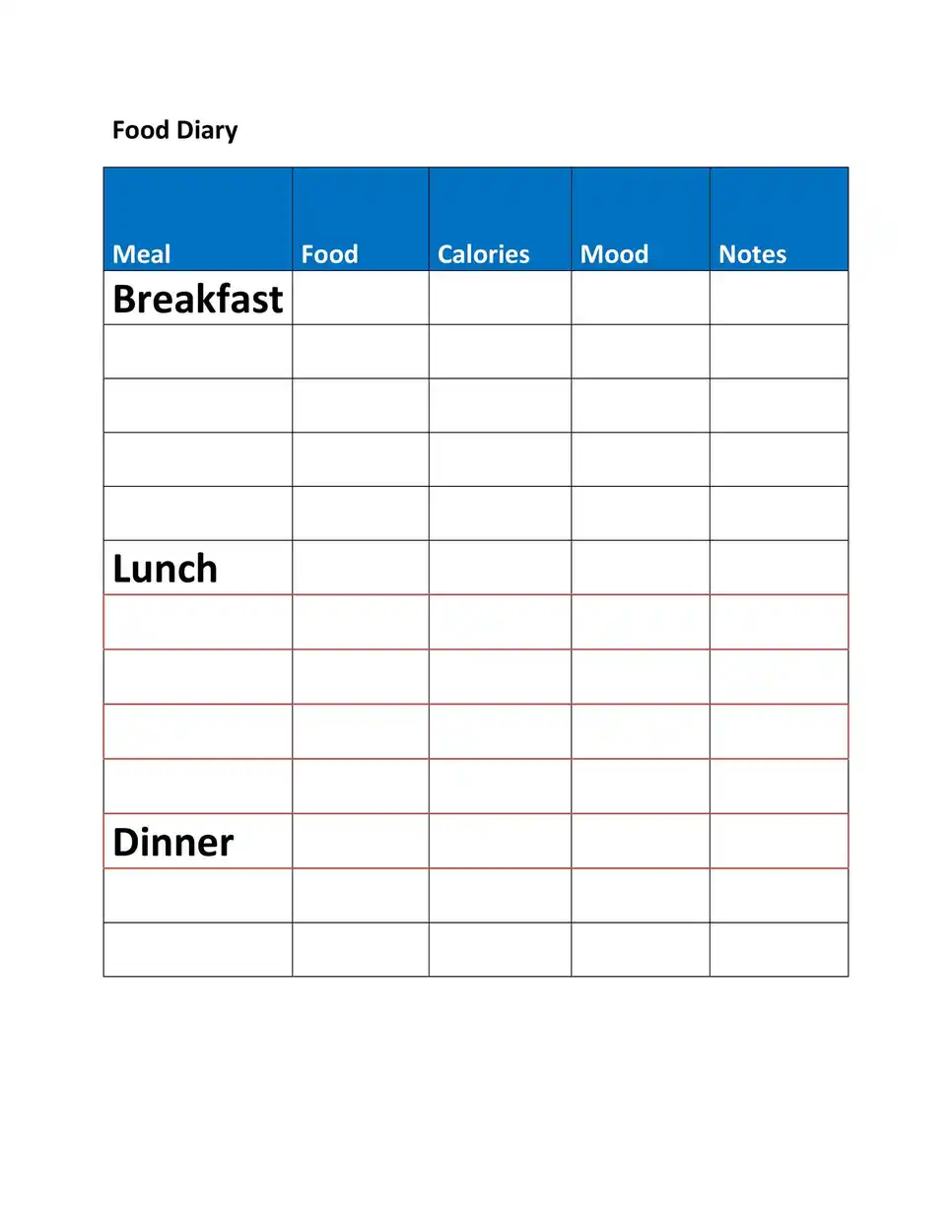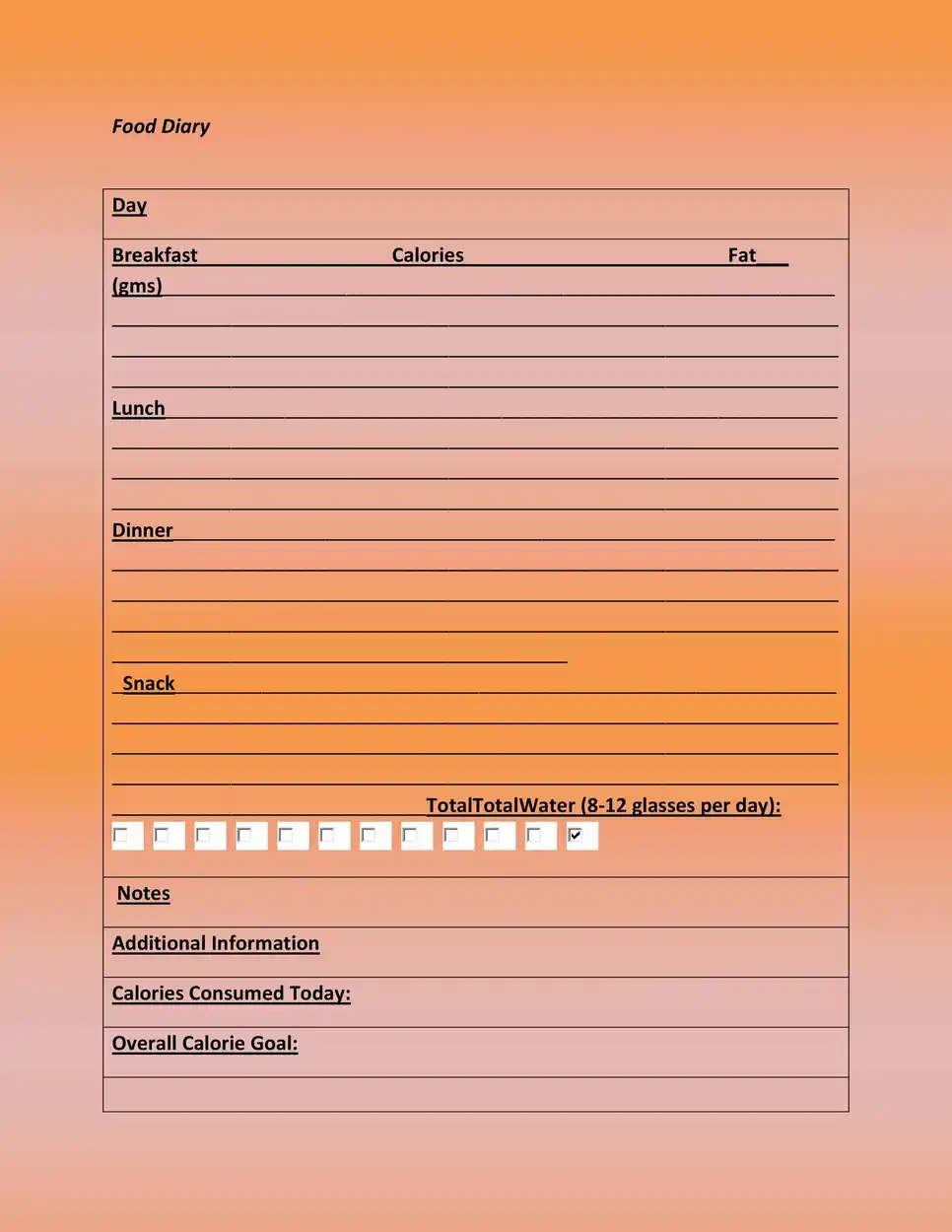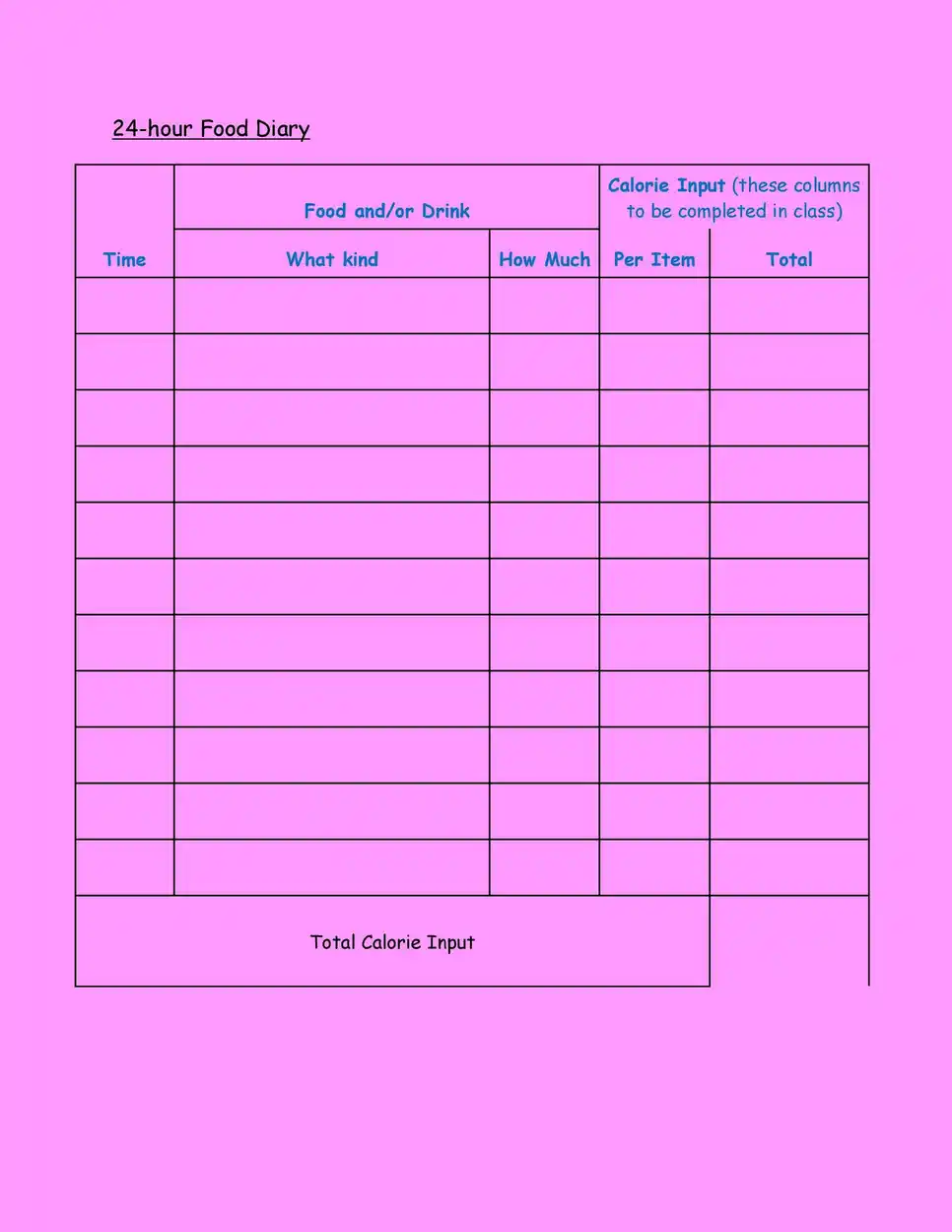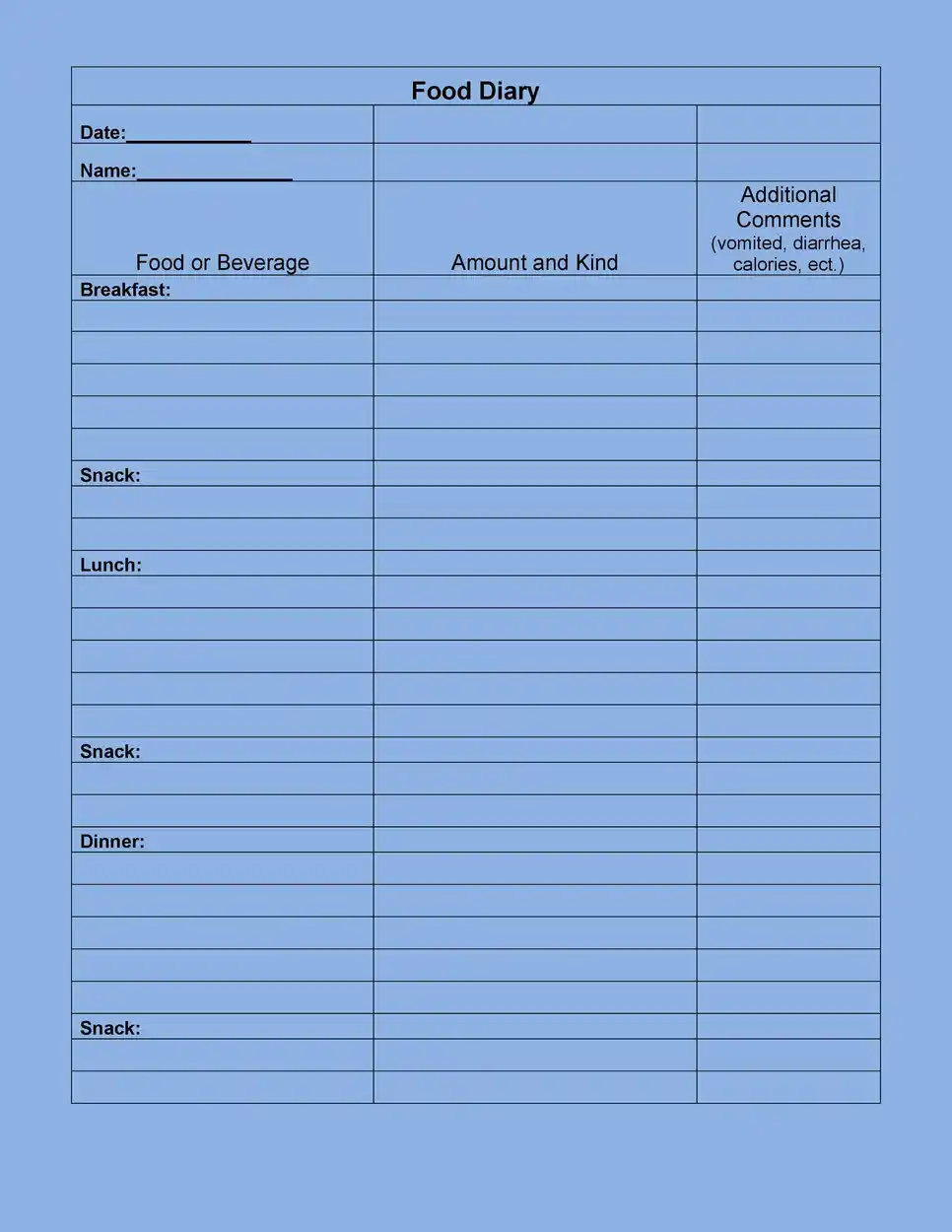Sample food diary template is a powerful tool that helps you track your food intake. By writing down what you eat and drink, you can understand your eating habits better and make healthier choices.
What is a Food Diary Template?
A food diary template is a structured form where you record everything you eat and drink. The main purpose is to help you keep track of your diet and understand your nutritional intake.
This can benefit weight loss, managing medical conditions, or improving overall health. It serves as a food intake log and dietary journal to aid in nutritional tracking.
How Can a Food Diary Template Help with Weight Loss?
Using a food diary template can be very helpful for weight loss. Here’s how it works:
Tracking Calories and Nutrients
Write down everything you eat and drink to see how many calories you consume. This is called calorie tracking. It helps you understand whether you are eating too much or too little and whether you are getting enough nutrients, like vitamins and minerals.
Spotting Patterns
A food diary template helps you find patterns in your eating habits. For example, you might notice that you snack a lot in the evening.
Making Better Food Choices
Knowing what you eat makes it easier to make healthier choices. For example, if you see that you are eating too many sugary snacks, you can try eating more fruits and vegetables instead.
Avoiding Overeating
Writing down your food helps you be more mindful of what you eat and can prevent you from eating too much. When you see how much you have eaten in a day, you might skip that extra snack. This is part of portion control, which means eating the right amount.
Setting Goals
A food diary template helps you set goals for your eating habits. For example, you can aim to eat more vegetables or drink more water.
Getting Support
You can share your food diary with a friend, doctor, or nutritionist.
Sample Food Diary Template
What Should Be Included in a Food Diary Template?
Here are the things you should include in your food diary:
Meal Categories
First, divide your food diary into meal categories. These categories are:
- Breakfast
- Lunch
- Dinner
- Snacks
Writing down your meals in these categories helps you see what you eat throughout the day.
Portion Sizes
This is called the portion size. For example, if you eat an apple, you can write “1 medium apple.” If you eat pasta, you can write “1 cup of pasta.” Knowing your portion sizes helps with portion control.
Calorie Count
To track your calories, write down the number of calories for each food item. Many food items have calorie information on their packages. You can also look up calorie counts online. This is part of calorie tracking.
Nutritional Information
You can also include other nutritional information, such as protein, fat, and carbohydrates. This helps with nutritional tracking, as you can see if you are getting enough nutrients each day.
Time of Eating
Write down the time you eat each meal or snack. This helps you see your eating patterns. For example, you might notice that you snack more in the evening.
Notes on Feelings and Hunger Levels
Include a section for notes. Here, you can write how you feel before and after eating. You can also write how hungry you are. For example, you might write “very hungry” before lunch and “full” after lunch. This helps you understand your eating habits.
Beverages
Don’t forget to include drinks in your food diary. Write down what you drink and how much. For example, write “1 cup of coffee” or “2 glasses of water.” Drinks can have calories, too, so it’s important to track them.
Any Reactions
If you have any reactions to food, like feeling sick or getting a rash, write it down. This can help you and your doctor identify food allergies or sensitivities.
Food Diary Example
Different Types of Food Diary Templates
You can choose the one that works best for you. Here are some options:
Printable Food Diary Templates

A printable food diary template is a form you can print out and fill in by hand. These are good if you like writing things down on paper. You can keep your food diary in a notebook or binder.
Digital Food Diary Templates
A digital food diary template is one you use on your phone, tablet, or computer. These are very handy because you can log your food anytime, anywhere. Many people find digital diaries easier to use than paper ones. You can also store more data without needing extra space.
Food Tracking Apps
Many apps act as food-tracking apps. These apps help you log your meals, count calories, and track nutrients. Some popular apps are MyFitnessPal, Lose It!, and Cronometer. These apps often have extra features, like barcode scanners to add foods or reminders to log your meals quickly.
Online Food Diary Templates
Some websites offer online food diary templates. You can log in to these sites and track your food. These online diaries can be accessed from any device with an internet connection.
Specialised Food Diaries
There are also specialised food diary templates for people with specific needs. For example, there are templates for people with diabetes, athletes, or those with food allergies. These templates focus on tracking things that are important for those groups.
Choosing the right food diary template depends on your personal preference.
Specific Types of Food Diary Templates
3 Day Food Diary Template

This short-term diary can be useful for quickly overviewing your eating habits. It is often used for medical or nutritional assessments.
Blank Food Diary Template

This template type is flexible and can be customized to fit your needs. You can include sections for meals, snacks, drinks, portion sizes, and more.
Children’s Food Diary Template

A children’s food diary template is designed for kids. It often includes fun elements like colorful sections and simple language to make it easy for children to fill out. This helps kids learn about healthy eating habits from a young age.
Daily Food Diary Template

This template helps you keep a detailed record of what you eat and drink daily, making it easier to spot patterns and make healthier choices.
Diabetic Food Diary Template
A diabetic food diary template is specifically for people with diabetes. It helps track carbohydrates and blood sugar levels along with food intake. This template is crucial for managing diabetes effectively.
Toddler Food Diary Template
A toddler food diary template tracks toddlers’ eating habits. This template helps parents ensure their toddlers are getting the right nutrients. It often includes sections for portion sizes, meal times, and food reactions.
Weekly Food Diary Template

A weekly food diary template helps you track your weekly food intake. This template gives you a broader view of your eating habits and is useful for long-term dietary changes.
Choosing the right food diary template depends on your personal preference and needs. Some people like the simplicity of a printable template, while others prefer the convenience of a digital one.
How to Make Food Diary More Effective?
To make your food diary work better for you, try these tips:
Be Honest and Detailed
Write down everything you eat and drink. It counts, even if it’s just a small snack or a sip of soda! The more honest you are, the more accurate your diary will be.
Write Down Portions and Calories
Include the portion size and calorie count for each food item. This helps with portion control and calorie tracking. You can find this information on food labels or online.
Note Your Feelings
Write how you feel before and after eating. Are you really hungry or just bored? This can help you understand your eating habits and make better choices.
Review Your Diary Regularly
Look at your food diary every week. Notice any patterns. Are you eating too many snacks? Are you skipping meals? Use this information to make healthier choices.
Set Goals
Set small, easy goals for yourself. For example, you might want to eat more vegetables or drink more water. Write these goals in your food diary and track your progress.
Is It Necessary to Track Drinks in a Food Diary?
It’s important to track what you drink in your food diary. Here’s why:
Hidden Calories
Many drinks have calories, even if they don’t make you feel full. Sugary drinks like soda and juice can add a lot of extra calories to your diet. You can see how many calories you are taking in by tracking your drinks.
Nutritional Value
Some drinks, like milk or smoothies, contain important nutrients. Tracking these can help you determine whether you are getting enough vitamins and minerals.
Staying Hydrated
Drinking enough water is important for your health. By writing down how much water you drink, you can ensure you stay hydrated.
Simple Food Diary Template



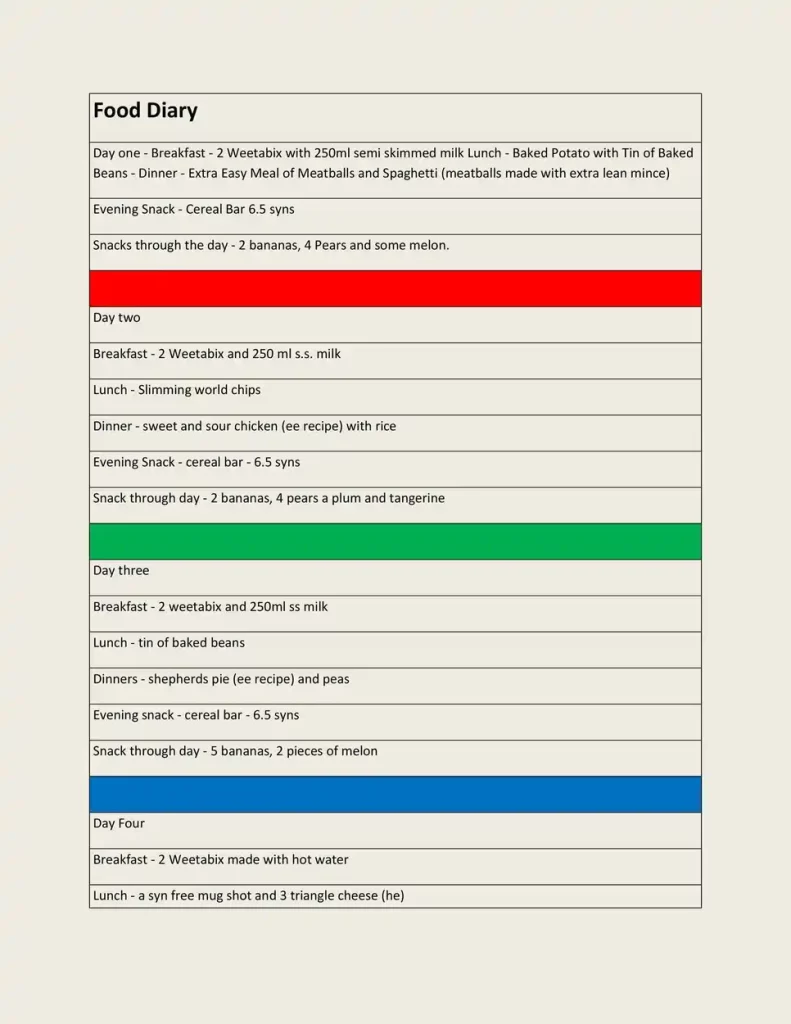




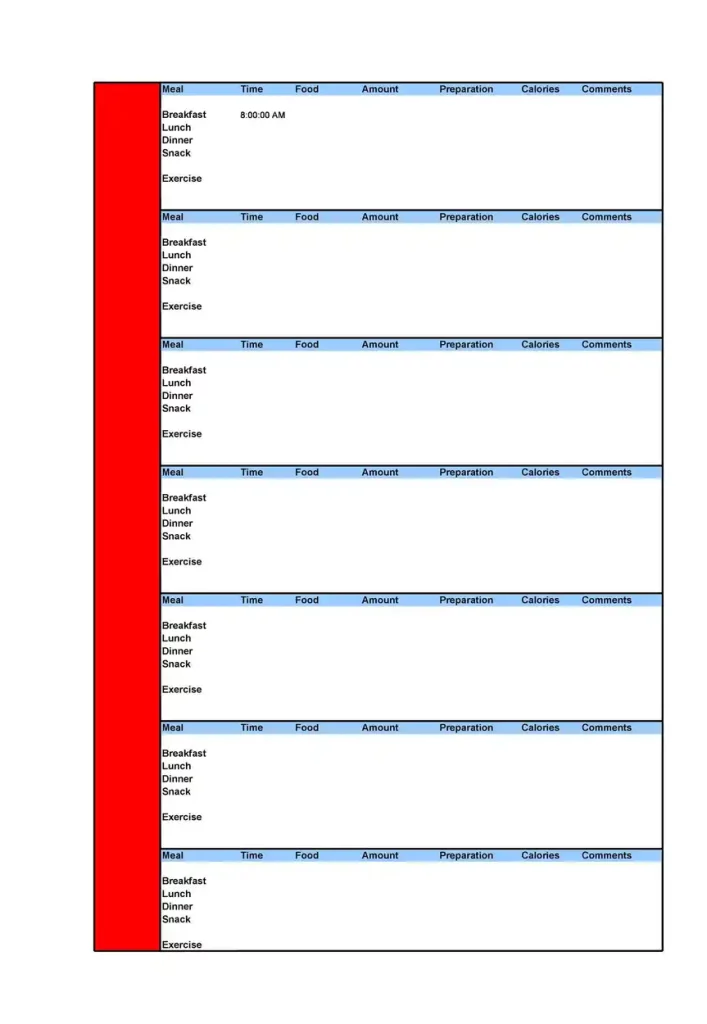



How to Use a Digital Food Diary Template?
Using a digital food diary template can make tracking your food easier. Here’s how to get started:
Choose an App or Template
There are many apps and online templates to choose from. Some popular food-tracking apps are MyFitnessPal, Lose It!, and Cronometer. Pick one that you like.
Set Up Your Profile
Most apps ask for information like age, weight, and activity level. This helps the app give you better advice.
Log Your Meals
Enter what you eat and drink into the app. Most apps have a large database of foods, so you can find the items you eat. Some apps even let you scan barcodes to add foods quickly.
Track Your Nutrients
Many apps can track more than calories. They can show you how much protein, fat, and carbohydrates you are eating, which helps with nutritional tracking.
Use Reminders
Some apps can send you reminders to log your meals. This helps you stay on track and remember to enter your food.
Review Your Progress
Look at your food logs regularly. See what patterns you notice and use this information to make healthier choices. You can also set goals in the app and track your progress.
How Often Should I Fill Out My Food Diary?
To get the best results, you should fill out your food diary every day. Here’s why:
Daily Tracking
Writing down everything you eat each day helps you remember all your meals and snacks. It makes your food intake log more accurate because you won’t forget any details.
Consistency is Key
Doing something the same way every time is called consistency. When you fill out your food diary every day, it becomes a habit.
Seeing Patterns
By tracking your food daily, you can see patterns in your eating habits. For example, you might notice you eat more snacks on weekends.
Staying Accountable
Writing down everything you eat makes you more aware of your food choices. This can help you avoid overeating or picking unhealthy foods. Being accountable to your daily meal log keeps you focused.
Adjusting Your Diet
Daily tracking helps you see if you’re getting enough nutrients, like vitamins and minerals. If you notice you’re missing something, you can adjust your diet. This helps with nutritional tracking and ensures you’re eating a balanced diet.
Can a Food Diary Help Identify Food Allergies?
Yes, a food diary can help you identify food allergies. Here’s how:
Tracking What You Eat
When you write down everything you eat, you can look back and see which foods might have caused a reaction. This is useful if you get a rash or stomach ache. Your dietary journal can help pinpoint the culprit.
Noting Symptoms
A food diary isn’t just for food. You can also note how you feel after eating. If you notice that you feel sick after eating certain foods, you might have a food allergy.
Sharing with Your Doctor
You can bring your food diary to your doctor. They can review your notes and help you figure out if you have a food allergy. This detailed record is very helpful for diagnosis.
Identifying Triggers
Keeping a detailed food intake log can help you identify which foods cause problems.
Monitoring Eating Habits
A food diary helps you keep an eye on your eating habits. If you notice certain foods make you feel bad, you can stop eating them. This helps you make better food choices and stay healthy.
Share Food Diary with Doctor or Nutritionist
Sharing your food diary with your doctor or nutritionist can be very beneficial. Here’s how and why you should do it:
How to Share Your Food Diary
- Printable Reports: Using an app like MyFitnessPal, you can print out your food diary. Log in to your account, go to the “Food” tab, and click “View Printable Report.” Choose the date range and print the report. You can also save it as a PDF and email it to your doctor or nutritionist.
- Digital Sharing: Some apps allow you to share your food diary directly. You can publicise your diary or share it with specific people by sending them a link. This feature is helpful if your doctor or nutritionist uses the same app.
- Screenshots: If you prefer, take screenshots of your food diary and email or message them to your healthcare provider. This is a quick and easy way to share your information.
Benefits of Sharing Your Food Diary
- Accurate Dietary Assessment: Your doctor or nutritionist can review your food diary to understand your eating habits. This helps them provide personalized advice and identify areas where you can improve.
- Identifying Allergies and Sensitivities: Healthcare professionals can help identify foods that may be causing allergies or sensitivities by reviewing your detailed food intake. This is especially important if you have been experiencing symptoms like stomachaches or rashes.
- Creating a Health Plan: Sharing your food diary allows your doctor or nutritionist to create a tailored health plan. They can suggest specific dietary changes or recommend supplements to ensure you get nutrients.
- Tracking Progress: Regularly sharing your food diary helps track your progress. Your healthcare provider can see if your changes are effective and adjust your plan as needed. This ongoing support is crucial for achieving long-term health goals.
Tips for Effective Sharing
- Be Honest and Detailed: Write down everything you eat and drink, including portion sizes and any toppings or extras.
- Regular Updates: Share your diary regularly, not just once. This gives your healthcare provider a better picture of your habits over time.
- Include Notes: Add notes about how you feel before and after eating. This can provide additional insights into your eating patterns and potential food-related issues.
For more details:
- FamilyDoctor.org
- MyFitnessPal Support
- iCliniq
In conclusion, keeping a food diary is a simple but effective way to track your eating habits and improve your health. Whether you use a printable template or a digital app, the key is consistency and honesty in your entries. Start your food diary today and take the first step towards a healthier you!

The content creator team at calipsotree.com is dedicated to making topics accessible to everyone, with over 9 years of experience in writing and breaking down complex concepts into easy-to-understand articles that answer readers’ financial questions.






